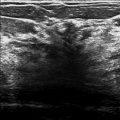Presentation and Presenting Images
( ▶ Fig. 81.1, ▶ Fig. 81.2, ▶ Fig. 81.3, ▶ Fig. 81.4, ▶ Fig. 81.5, ▶ Fig. 81.6, ▶ Fig. 81.7, ▶ Fig. 81.8, ▶ Fig. 81.9)
A 57-year-old male with a history of follicular lymphoma had a routine follow-up chest computed tomogram (CT), which revealed a mass in the retroareolar right breast. He presents for diagnostic mammographic evaluation.
81.2 Key Images
( ▶ Fig. 81.10, ▶ Fig. 81.11, ▶ Fig. 81.12)
81.2.1 Breast Tissue Density
Breast tissue density is not typically evaluated in male patients.
81.2.2 Imaging Findings
The chest CT shows an asymmetrical soft tissue lesion in the right retroareolar region that is larger when compared to the prior CT ( ▶ Fig. 81.1, ▶ Fig. 81.2, ▶ Fig. 81.3). Conventional mammographic imaging of the right breast confirms the CT findings and demonstrates asymmetric breast tissue on the right breast compared to the left ( ▶ Fig. 81.10, ▶ Fig. 81.11, ▶ Fig. 81.12). Digital breast tomosynthesis (DBT) imaging reveals only breast tissue and no underlying mass lesions.
81.3 BI-RADS Classification and Action
Category 2: Benign
81.4 Differential Diagnosis
Gynecomastia: Gynecomastia, defined as benign proliferation of male breast glandular tissue, is usually caused by increased estrogen activity or decreased testosterone activity or is secondary to numerous medications.
Breast cancer: Breast cancer in men occurs approximately 100 times less than in women. The lifetime risk of having breast cancer is 1 in 1,000 for men.
Lymphoma: Primary lymphoma is less common than secondary lymphoma and is typically a B-cell type of non-Hodgkin’s lymphoma (NHL). Primary non-Hodgkin’s lymphoma of the breast represents only ~ 0.25% (range 0.12–0.53%) of all reported malignant breast tumors.
81.5 Essential Facts
CT can identify incidental breast lesions when performed for cardiopulmonary evaluation. Indeterminate and suspicious CT-identified breast lesions should be further evaluated with mammography.
This is a male patient and although breast cancer is rare in males, mammography should be performed to further evaluate CT-identified breast lesions in males.
Gynecomastia is described as hyperplasia of the ductal and stromal elements of the male breast. It typically presents as a soft, mobile, painful mass.
There is an association between gynecomastia, decreased testosterone, and increased estradiol. The increased estradiol–testosterone ratio may result from physiological changes at puberty and senescence or may be secondary to endocrine and hormonal disorders, neoplasms, and certain drugs and medications.
81.6 Management and Digital Breast Tomosynthesis Principles
DBT may be safely performed on male patients.
DBT’s ability to remove overlapping tissue allows for evaluation of dense subareolar breast tissue.
81.7 Further Reading
[1] Appelbaum AH, Evans GFF, Levy KR, Amirkhan RH, Schumpert TD. Mammographic appearances of male breast disease. Radiographics. 1999; 19(3): 559‐568 PubMed
[2] Braunstein GD. Clinical practice. Gynecomastia. N Engl J Med. 2007; 357(12): 1229‐1237 PubMed
[3] Moyle P, Sonoda L, Britton P, Sinnatamby R. Incidental breast lesions detected on CT: what is their significance? Br J Radiol. 2010; 83(987): 233‐240 PubMed

Fig. 81.1 Axial contrast-enhanced computed tomogram (CE-CT) of the chest on soft tissue window.
Stay updated, free articles. Join our Telegram channel

Full access? Get Clinical Tree








